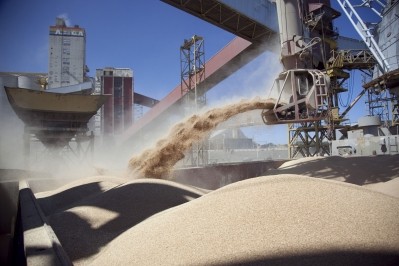USDA: Soybean exports expected to see boost in 2020

The US Department of Agriculture (USDA) released new perspectives on feed and agricultural exports in a recent report on the outlook for US agricultural trade.
Overall, total US agricultural exports are anticipated to increase to $137bn for fiscal year 2020, said report authors Kamron Daugherty and Hui Jiang, coordinators at the USDA’s Economic Research Service (ERS).
“Pork exports are forecast at $6.3bn (up $800m from FY 2019) as a result of higher volumes and unit values, partially resulting from the repeal of Mexico’s retaliatory tariffs and an increase in global pork demand due to the African Swine Fever (ASF) epidemic.”
“Soybean exports are forecast to rise $400m to $16.8bn on higher volumes,” they added.
However, feed and related ingredients are not expected to see much change from previous forecasts.
Exports are also expected to increase to Canada, Mexico and China – based on increased pork sales, they said.
However, for fiscal year 2019 export forecasts have been lowered $2.5bn to $134.5bn from previous estimations, the authors said. “[This is] mainly due to reductions in exports of corn, soybeans, and other oilseeds,” they added.
Trading partners in 2020
Exports to Canada are anticipated to increase by about $400m from fiscal 2019 to reach $21.5bn, the authors said. Sales to Mexico are slated to grow by $500m and reach $19.9bn.
“Exports to South America are down $500m to $6.5bn; soybean sales to Argentina are expected to decline as the country recovers from the recent drought,” they said.
“Agricultural exports to China are forecast at $7.5bn, an increase of $200m from FY 2019, on higher expected pork sales,” they said.
China’s demand for soybeans is predicted to be “restrained” based on ongoing trade tensions and ASF, they noted.
However, the forecast for exports to China in 2019 have been increased by $800m based on surges in shipments of pork and soybeans, they added.
However, exports to Japan are anticipated to increase to $12.8bn and those to South Korea are expected to reach $8.5bn from the demand for beef, pork and soybeans, the authors said. Exports to Taiwan also are forecast to grow based on demand for soybeans and animal proteins.
Exports to parts of Southeast Asia are expected to increase as are those to South Asia based on import interest from Pakistan, they said.
Europe is forecast to see increased exports from 2019, based on feed ingredients and horticultural products, while exports to the Middle East and Africa remain flat from 2019, they said.
Feed ingredients, animal protein exports
Feed and feed ingredient exports for fiscal 2020 are forecast to be about $30.1bn, similar to the revised estimates for exports in 2019, the report authors said.
“Corn exports are forecast up $200m to $9.4bn on larger volumes but lower unit values, as easing supply concerns have improved the prospects for US exporters,” they said. “Sorghum exports for FY 2020 are forecast at $400m, unchanged from the FY 2019 estimate.”
“Exports of feeds and fodders are forecast at $7.7bn, down $200m on lower projected unit values,” they added.
In fiscal 2019, grain and feed exports have been reduced from previous forecasts to $30.1bn based on the drop in corn exports, the report authors said.
“US corn has faced strong competition in recent months from an abundant South American corn harvest, and this is expected to continue through September,” they said. “Feed and fodder exports are forecast at $7.9bn, up $200m on higher unit values.”
Oilseed exports in 2020 are anticipated to be up about $400m reaching $25.6bn, the authors said. The change is based on increased soybean volume.
“Despite a nearly-20% decline in the projected 2019 soybean harvest due to reduced plantings and lower yields, a record carry in stock of more than 29m metric tons assures more-than-adequate supplies,” they said. “Together with little year-over-year growth in global soybean demand – due primarily to lower demand in China in response to ASF and constraints on China’s purchases of US soybeans in response to continuing trade frictions – export unit values are expected to decline slightly.”
“Soybean exports are forecast to rise $400mn to $16.8bn in FY 2020, while soybean meal exports are projected down 2% to $4.4bn,” they added.
China’s demand for soybeans from the US remains an “unknown,” the authors said. However, the premiums on soybeans from South America are expected to improve the competitiveness of US soybeans and soybean meal.
In 2019, the export forecast for oilseeds has declined $1.2bn to $25.2bn based on a weaker than anticipated global demand, they said.
Livestock, poultry and dairy product exports are forecast to improve in 2020 reaching $31.4bn, the authors said. The change is based mostly on strong volumes and prices for pork, beef and chicken.
Exports of beef and veal are anticipated to reach $7.8bn, an increase of $300m from the current fiscal year, they said. Poultry exports are expected to climb to $5.3bn, while dairy product exports drop to $5.5bn.
Importing practices
US imports of agricultural products are expected to decline slightly to $129bn in fiscal year 2020, the authors said. Feed and feed ingredient imports are expected to drop $200m and help offset an anticipated bump in oilseed and oilseed product imports.
“US agricultural imports in FY 2019 are expected to reach $129.3bn – $300m larger than the previous forecast,” they said. “The biggest adjustments [from earlier estimates] are derived from increases in livestock, dairy, and poultry and in grains and feeds and decreases in oilseeds and products and sugar and tropical products.”
In 2020, the prediction is that imports of dairy, livestock and poultry should increase by about $100m, they said. Imports of oilseeds and related products are also expected to grow to reach about $9.4bn, although imports in 2019 fell.
“In FY 2020, US grain and feed imports are forecast at $13bn, $200m below the FY 2019 forecast,” they said. “This forecast decrease is largely driven by a $300m decrease in grain product imports.”
“Conversely, the forecast level of grain and feed imports for FY 2019 reflects a $400m increase to $13.2bn,” they added. “Grain products account for $200m of that increase; for FY 2019, US imports of grain products are expected to total $9bn. Growth in grain and feed imports is projected.”












